|
- The caterpillar connection
- More power for mussel work
- Team Tortoise bodes well for gophers
 Tomato hornworm, larva of a sphinx moth (Terry W. Johnson)
By TERRY W. JOHNSON
Would you believe me if I said you could help preserve and enhance our native plant and animal heritage as well as the environmental health of Georgia without ever leaving your home? Probably not.
If I went on to say you could do this by encouraging caterpillars in your yard, you would probably be convinced I was out of my mind. In truth, however, this isn’t as far-fetched as it may sound.
Research probing the loss of habitat has revealed a critical connection between declining numbers of native plants and the resulting impact on caterpillars, one of if not the most important food source for birds and other animals. ...
For more on this issue and what you can do, read the rest of Terry’s column.
Terry W. Johnson is a retired DNR nongame program manager and executive director of TERN, Nongame Conservation’s friends group. Read more in the Out My Backdoor library, on Terry's Backyard Wildlife Connection blog and in his book “A Journey of Discovery: Monroe County Outdoors.”
Back to top.
 Georgia Power, the U.S. Fish and Wildlife Service and Georgia DNR have teamed up in a 30-year effort to study and conserve five freshwater mollusk species with ties to the Altamaha River basin.
The candidate conservation agreement announced Aug. 31 at Georgia Wildlife Federation headquarters in Covington centers on four mussels – the delicate spike, Altamaha arcmussel (pictured), inflated floater and Savannah Lilliput – and a snail species, the reverse pebblesnail. Although four of the five had been petitioned for Endangered Species Act listing, all but the delicate spike have been withdrawn.
Yet all five are species of conservation concern in Georgia’s State Wildlife Action Plan. Scientists agree that a better understanding of their distribution and ecology is needed and will strengthen measures to reduce threats, work that will improve water quality and conserve mollusks, animals that are crucial to keeping aquatic ecosystems healthy.
“Through the power of partnerships,” said DNR Wildlife Resources Division Director Rusty Garrison, “we’re able to focus on conserving the species that need our help.”
Back to top.
|
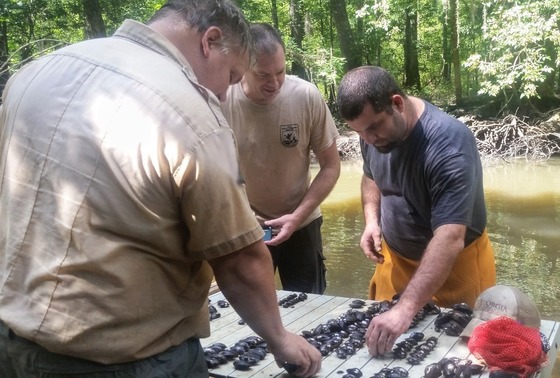 Mussel survey in progress (Melissa Keneely/DNR)
By MELISSA KENEELY
When you think of rare animals, freshwater mussels are probably not the first animals that come to mind. Yet mussels rank as one of the most imperiled groups of animals on Earth.
An estimated 70 percent of all known freshwater mussel species are considered at risk of extinction in the near future.
As a seasonal field tech with DNR’s Nongame Conservation Section, I’ve had the awesome job of working with these unique creatures all summer. From searching stream beds for mussels to learning about their complex life cycles and vital importance to aquatic habitats, it has been eye-opening …
Find out about Melissa’s work with mussels in this blog post.
Melissa Keneely is a recent graduate of UGA’s Warnell School of Forestry and Natural Resources.
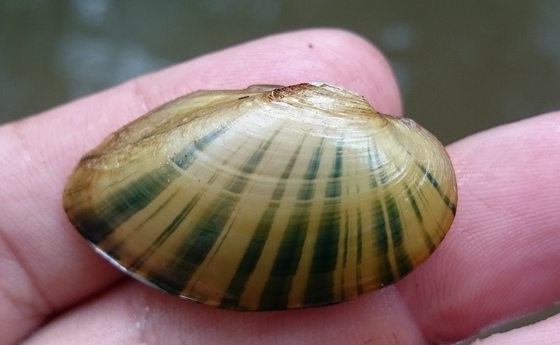 Shinyrayed pocketbook (Melissa Keneely/DNR)
P.S.: SPRING CREEK FINDS
Melissa
also sent this postscript:
"While many creeks were swollen by late-July
rains, some remained low enough to sample. Nongame Conservation sampled
Spring Creek in southwest Georgia’s Miller County as part of an ongoing
evaluation of stream flows on mussel populations there. Of 355 mussels
found, 35 were federally endangered shinyrayed pocketbooks or oval
pigtoes. The shinyrayed pocketbook is regarded as one of North America’s
most beautiful mussels. The one pictured certainly lived up to the
claim!"
For more “Day in the Life” insights, check out Kathleen Allen’s post as part of DNR’s gopher tortoise crew.
Back to top.
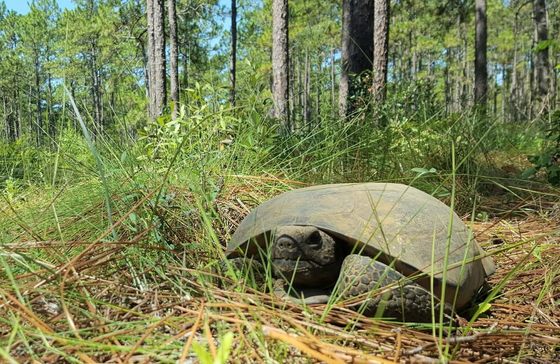 Gopher tortoise at Doerun Pitcherplant Bog WMA (Joe Burnam/DNR)
By DAN CHAPMAN
Typically, animals like the Florida panther lose their Southern habitat, dwindle perilously close to extinction and end up on the endangered species list. Federal, state and non-profit groups hustle to raise money and conserve land to bolster the populations with the chance, one day, of delisting it.
The gopher tortoise, though, just might buck the trend.
An at-risk species in Georgia, Florida and parts of Alabama and South Carolina, the tank-like tortoise is the recipient of an unprecedented, high-dollar collaboration between government agencies, NGOs and the private sector to keep Gopherus polyphemus from ever gracing the threatened or endangered species list. …
Read the rest of this U.S. Fish and Wildlife Service post about the unprecedented effort Georgia is leading to conserve gophers.
Dan Chapman is a public affairs specialist with the Fish and Wildlife Service’s Southeast region. Find conservation articles like this on the agency’s website. Included: Longleaf pine for Georgians.
Back to top.
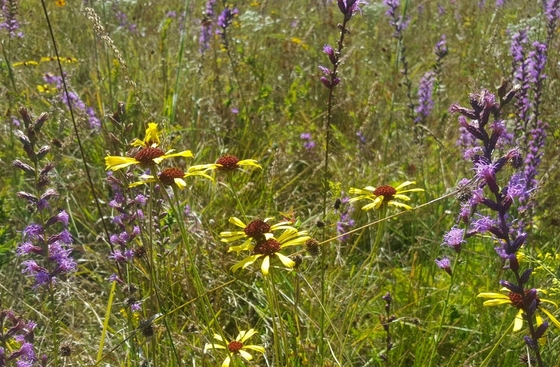 Purple honeycomb flowering at Canoochee Bogs (Lisa Kruse/DNR)
An Oconee River Land Trust and DNR project to protect southeast Georgia's Canoochee Bogs has received a $27,000 U.S. Fish and Wildlife Service grant, and the Land Trust is within about $4,300 of raising the remaining funds needed. The Canoochee Bogs provide key habitat for three carnivorous pitcherplant species, seven orchid species, gopher tortoises and migratory birds.
Georgia's nest total for loggerhead sea turtles this year topped 2,140 nests, below last year's record 3,289 nests but far above the state's annual average of 1,300 nests since comprehensive surveys began in 1989. The loggerhead population is increasing at approximately 3 percent a year. Nests still incubating will be monitored and inventoried through mid-October by Georgia Sea Turtle Cooperative members.
Research probing the
rock-and-a-hard-place scenario of nesting MacGillivray’s seaside sparrows
squeezed by sea-level rise and predators on Georgia’s coast made headlines in The Washington Post.
The Nongame Conservation Section helped fund the work done by doctoral student
Elizabeth Hunter, formerly of UGA and now of the University of Nevada at
Reno.
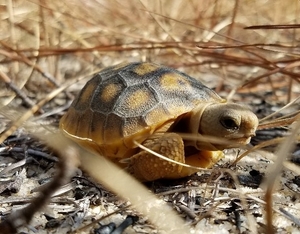 ‘Tis the season for gopher tortoise hatchlings. DNR’s gopher tortoise crew spotted the youngster at left on Sandhills West Wildlife Management Area, near Butler.
Berry College and Georgia Power installed two new cameras at the bald eagle nest on the school’s campus after a power surge killed the previous cams. Measurements taken during the treetop installation – the young fledged in May – revealed that at 83 inches in diameter, the nest is as large as a king-sized bed. 2017 season recap. Also watch at georgiawildlife.com.
|
For the first time, summer mist-net surveys for bats on St. Simons
Island landed a northern yellow bat, a species of conservation concern
in Georgia’s State Wildlife Action Plan. The surveys conducted this year
by DNR and U.S. Fish and Wildlife Service staff at Cannon’s Point
Preserve on St. Simons and on Little St. Simons Island provide needed
inventory data on bats along Georgia’s coast.
Ten manatees tracked in a Georgia study of their movements were found this week from Sunset Beach, N.C., to Titusville, Fla., with tagged manatees also at Hilton Head, S.C., Sapelo Island, Brunswick and Naval Submarine Base Kings Bay ("Tracking more manatees," June 15). A female nicknamed AnnaKat appeared pregnant when tagged, and since early July has been seen with a small calf, apparently hers. Two manatees tagged in 2016 lost their tags in South Carolina last month. Watch this Georgia Aquarium video about the project.
DNR's Wildlife Resources Division landed four awards during the annual Association for Conservation Information contest: firsts for conservation post of the year (the Georgia Wild video on hummingbirds) and news release ("Sea turtle recovery hits nesting benchmark"); second for publications (the 2016 Nongame Conservation Section annual report); and third in newsletters for Georgia Wild. The national contest drew a record 450 entries from state and other wildlife agencies.
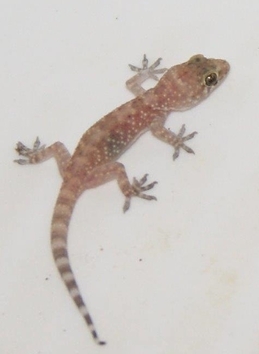 Mediterranean geckos occasionally turn up in metro Atlanta and other urban and suburban areas across much of Georgia. Arty Schronce, who writes Arty’s Garden in the state Agriculture Department’s Market Bulletin, found this one (left) at his Atlanta home recently. Nongame Conservation senior wildlife biologist John Jensen said the species with the ultra-sticky toe pads is non-native but not necessarily invasive, a hitchhiker from places such as Florida where it’s well established.
Names in the news: Georgia’s Envirothon team, from Vantage Point High School in Gwinnett County, placed eighth out of 54 teams in the National Conservation Foundation Envirothon competition. Coached by Trish Foster, team members included Cooper Foster, Phillip Alexander, Emma Alexander, John Deitsch and Nadya Gutierrez. The Peace Officers Association of Georgia presented DNR Law Enforcement Division director Col. Eddie Henderson the Arthur Hutchins Award for Meritorious Service. The annual award honors law enforcement leaders who have provided exemplary service to Georgians and made significant contributions to enhance the public safety profession. Gov. Nathan Deal has appointed Chuck Williams, of Oconee County, director of the Georgia Forestry Commission. Williams, a state representative and Georgia Tree Farmer of the Year in 2015, fills the vacancy created when former Director Robert Farris retired. The Satilla Riverkeeper named Dr. Clay Montague, of Camden County, its Conservationist of the Year. Formerly regional forester for the Southern Region, Tony Tooke was recently sworn in as chief of the U.S. Forest Service.
Back to top.
|
COMING UP
Sept. 23 – National Hunting and Fishing Day, including kids’ fishing events and a free fishing day
Sept. 23 – Monarchs Across Georgia Pollinator Symposium, 9 a.m.-4 p.m., Monastery of the Holy Spirit, Conyers
Sept. 28 – Georgia Prescribed Fire Council annual meeting, UGA Tifton Campus Conference Center, Tifton
Oct. 7 – CoastFest 2017, DNR Coastal Regional Headquarters, Brunswick
Oct. 20 – Outdoor Learning Symposium, Southwest Atlanta Christian Academy, Atlanta
WHAT YOU MISSED ...
in the last Georgia Wild:
- White-nose syndrome survey results
- How to sort out summer hummers
- Working Georgia’s turtle beaches
- Conserving Altamaha "paradise"
Back top.
"Sea turtle nests beat state averages in Georgia, Carolinas," The (Charleston, S.C.) Post and Courier, and others via AP
"A dozen right whale deaths documented," Savannah Morning News
"Feds to resume most whale disentanglement efforts," Maine Public Radio
"Nature's last stand" (professor Bill Ensign and restoration at Raccoon Creek), Kennesaw State University
"The tortoise and the lair," Garden & Gun
"Partnership makes headway for gopher tortoise," SaportaReport
"Grunt work pays off for Georgia’s sea turtles," Savannah Morning News
(+ video) "DNR looking for volunteers," WGXA-TV (Macon)
"Silent seashores? Scientists, conservationists team to protect shorebirds," National Wildlife
"Regional bats face ‘steep decline,'" The Newnan Times-Herald
"Seaside sparrows caught between predators and rising seas," phys.org, citing study in The Condor: Ornithological Applications
"Meet the 10 threatened plants, animals native to Cobb County," Marietta Daily Journal
"The river runs through us," Water Currents blog, National Geographic
"Georgia coast may soon be official shorebird stop," Savannah Morning News
"Williams to lead Georgia Forestry Commission," Athens Banner-Herald
"Camp TALON soars again," The GOShawk (Georgia Ornithological Society newsletter)
"Conservation stewardship 210 years in the making: the Bembry's longleaf legacy," USDA Natural Resources Conservation Service
"Scientists blitz bats at Mammoth Cave," Glasgow (Ky.) Daily Times
"Georgia awarded $1.3 million for wildlife protection projects," Marietta Daily Journal
VIDEO & AUDIO
Young osprey tries for fish handout at Landings nest, Savannah Bird Cam
(audio) "Burrowing owls hiss like a rattlesnake," BirdNote
"Little turtle is amazingly fast," Tastefully Offensive
"Butterfly transformation: caterpillar to chrysalis," Allen Miller
Back to top.
Masthead image: southern rainbow mussels (Melissa Keneely/DNR)
|